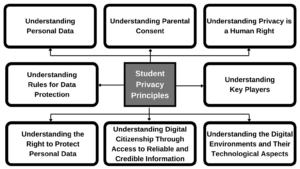- Privacy in Digital Learning: What should students expect regarding their privacy when learning online? Think about what level of privacy is reasonable, and why.
In this era of globalized information, protecting personal privacy is extremely important. I think students expect regarding their privacy when learning oSchools can affect student privacy in the following situations. First, the confidentiality of personal information. Even if the security of the learning platform is high, once personal information is leaked, students will face some unnecessary troubles: identity theft, harassment or other malicious activities. Secondly, the confidentiality of academic records. Students’ homework records and grades should only be provided for personal use. I think students deserve the highest level of privacy. Because most students are not yet fully mature mentally, they cannot accurately judge the right and wrong of online information. Preventing the leakage of students’ personal information will help students focus on learning.
- Privacy vs. Educational Needs: Sometimes, schools or teachers might need to use tools or take actions that could affect student privacy. Can you think of situations where this might be acceptable or necessary? How can we balance the need to protect student privacy with the need to meet educational goals?
Schools can affect student privacy in the following situations. First, the use of digital platforms. Schools usually use some digital platforms as teaching tools, so using these digital platforms usually requires providing privacy to register an account. Second, communication between teachers and students usually uses digital tools such as email, which is also part of student privacy. Third, schools usually provide extra care for students with disabilities, which means that students with disabilities need to provide additional personal information.I will propose the following points to balance the need to protect student privacy with the need to meet educational goals. First, ensure transparency of information. Schools need to explain to students and parents how information is stored and used. Second, strengthen the security of the website. Third, ensure that personal information is anonymized externally.
- Universal Design for Learning: Reflect on the UDL framework. Originally, it was created to help students with learning disabilities, but now it aims to prevent all types of exclusion. How can UDL effectively be used in digital learning to ensure every student has access and feels included?
The Universal Design for Learning (UDL) is contributed by three parts:Multiple Means of Engagement, Multiple Means of Representation and Multiple Means of Action and Expression. I think the development of UDL principles needs strong support from schools and society. Schools can create interactive platforms and provide continuous training on UDL for teachers. Society needs to be more inclusive and participatory in this type of learning platform. Not only do students need to participate in platform interactions, but parents also need to provide continuous feedback on the platform.

- Ethics and Digital Tools in Education: What ethical considerations should be taken into account when choosing and using digital tools in education? How can educators and institutions ensure they are using technology ethically?
I think the following ethical considerations need to be considered when choosing and using digital tools in education. First, the privacy of the platform. Second, the convenience of the platform. Third, the source of platform information needs to be formalized. Similarly, when educators use these platforms, they also need to be supervised by students and parents to prevent unfairness and information leakage.
Here are some tips for students to protest their privacy from digital platform.https://www.youtube.com/watch?v=qZE45J-MIUg&t=44s